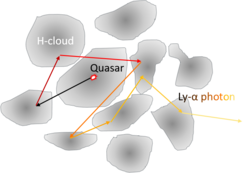Reflected quasar light powers giant cool gas nebulae
Already in the early Universe, supermassive black holes with masses a billion times larger than the Sun appear to inhabit the centres of massive galaxies. As interstellar gas is accelerated in their powerful gravitational field, it emits copious amounts of radiation, outshining the entire galaxy as “quasars”. Recent observations have revealed that the first quasars are often surrounded by bright, giant nebulae. These can span up to several 100,000 light years, about ten times larger than their host galaxy. New detailed computer simulations of galaxy evolution performed at MPA have shed new light on these puzzling observations, reproducing them in striking detail. According to these new theoretical models, the observed extended nebulae can be explained as quasar light that reflects off cool neutral hydrogen clouds surrounding the quasar host galaxy. Crucially, this mechanism only works if the energy provided by the quasar is able to produce gigantic galactic winds that blow out large masses of gas from its immediate vicinity. This finding suggests that quasars shape galaxy evolution from the earliest stages of galaxy formation.
Hydrogen is the most abundant element in the Universe – and the simplest: the hydrogen atom comprises a proton and an electron. If the electron encounters a photon with enough energy or if it collides with a free electron, it gains energy. The electron can also lose energy by producing a new photon. As the hydrogen atom thus interacts with matter and radiation, the electron in the hydrogen atom essentially hops up and down an “energy ladder”. The transition between the first excited state of hydrogen (the first step in the ladder) and its ground (or normal) state is called “Lyman-alpha”. This transition is ubiquitous in space and results in such bright emission that it can be seen out to distances of billions of light-years, where it can be used to probe galaxies in the early Universe.

The propagation of Lyman-alpha radiation is an extremely complex process, because photons are easily absorbed by neutral hydrogen, exciting it to the first energy state. Excited hydrogen gas immediately produces Lyman-alpha photons, which can again interact with neutral hydrogen. As they travel from their point of origin out into intergalactic space, Lyman-alpha photons thus repeatedly bounce off neutral hydrogen before eventually reaching our telescopes (see Figure 1). With each bounce, the frequency of most Lyman-alpha photons changes by a small amount due to the Doppler effect. Ultimately, if many collisions occur, the frequency can change so much that the photon is no longer in "resonance" with neutral hydrogen and can no longer be absorbed efficiently.
The recent detection of giant Lyman-alpha nebulae around some of the most distant known quasars poses significant puzzles: what is the nature of the abundant neutral hydrogen reservoirs around the first supermassive black holes? How are these clouds lit up?
New answers have been provided by researchers at MPA, who were able to reproduce these observations with new, detailed simulations of galaxy evolution. According to their study, Lyman-alpha nebulae trace pristine cool gas on its long journey from the intergalactic medium to the centres of galaxies, where it can form new stars and grow the central supermassive black hole.

The simulations also propose multiple explanations for how these giant cool gas clouds become bright in Lyman-alpha. According to one scenario, Lyman-alpha radiation appearing to emanate from the surroundings of quasars is actually produced by the quasar itself in the central regions of the host galaxy. On their way to the observer, these photons reflect off in-falling neutral hydrogen gas out to distances of several 100,000 light years from the quasar, powering a large bright nebula. Interestingly, this mechanism only works if one main condition is satisfied: the energy injected by the quasar must clear out gas from the central regions of the galaxy. If this blowout does not occur, then the Lyman-alpha photons are trapped in the galactic centre. There, they gain such extreme frequency shifts that they cannot interact with neutral gas outside of the galaxy. In this case, the nebula disappears (left-hand side of Figure 2).
However, if the quasar reduces amount of hydrogen gas in its host galaxy, the Lyman-alpha photons can escape out to large distances, where they still interact and reflect off neutral gas. The resulting nebulae are extremely similar to those observed around the first quasars (middle and right-hand side of Figure 2). This close match between theory and observation provides evidence that quasars affect the properties of their hosts since the earliest stages of galaxy formation in the Universe.













